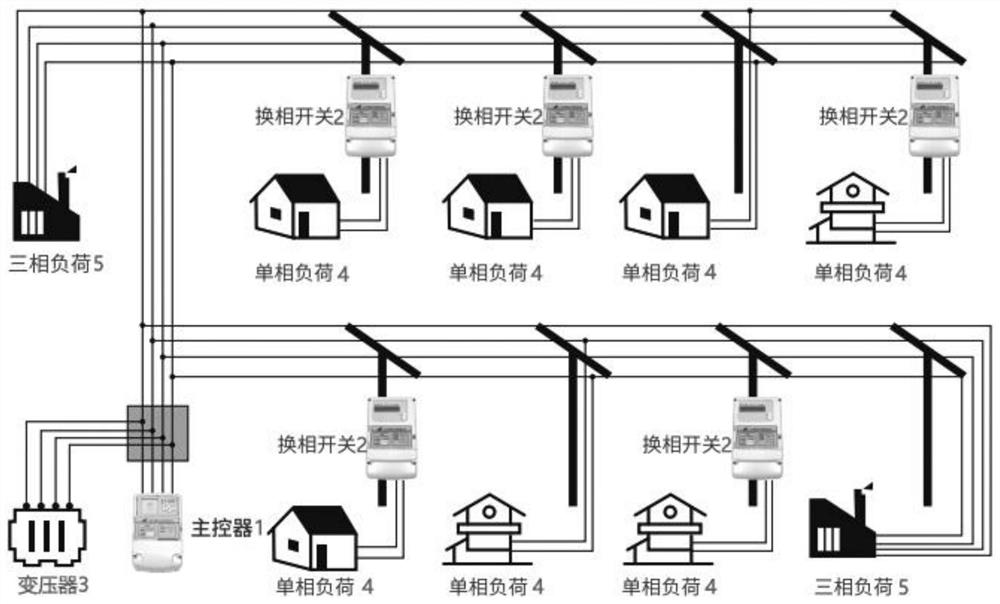Three-phase imbalance adjusting device and method based on phase-change switch
A technology of commutation switch and balance adjustment, which is applied in the direction of reducing the asymmetry of the multi-phase network and eliminating/reducing the asymmetry of the multi-phase network. Achieve the effects of convenient unified management, extended service life and wide application range
- Summary
- Abstract
- Description
- Claims
- Application Information
AI Technical Summary
Problems solved by technology
Method used
Image
Examples
Embodiment 1
[0077] This embodiment provides a three-phase unbalance adjustment device based on commutation switches, including a main controller 1 and several commutation switches 2 . Such as figure 1 As shown, the main controller 1 is installed at the outgoing line end of the transformer 3, and the phase change switch 2 is installed at the incoming line end of the corresponding single-phase load 4. When put into use, all the incoming lines of the single-phase load 4 can be A phase-changing switch 2 is installed at each terminal, and a phase-changing switch 2 can also be selectively installed at the incoming line terminals of several single-phase loads 4, which can be installed by technicians as required. The phase change switch 2 is not installed at the incoming line end of the three-phase load 5 . Each reversing switch 2 is communicatively connected to the main controller 1 corresponding to the station area. The main controller of this embodiment adopts the main controller of Yunuo Co...
Embodiment 2
[0080] Such as figure 2 As shown, this embodiment provides a three-phase unbalance adjustment method based on a commutation switch, including the following steps:
[0081] S1. The main controller 1 obtains the electric energy parameters including the degree of unbalance, and compares the current degree of unbalance with the threshold value of the degree of balance;
[0082] S2. When the current unbalance degree continuously exceeds the balance degree threshold within the set time period, that is, when the duration of the state where the unbalance degree is greater than the balance degree threshold reaches the set time, the main controller 1 traverses each commutation switch 2, Obtain switch data such as the current phase, current, historical number of actions, and whether there is a self-test fault of each phase-changing switch 2, and then obtain the switching data, sampling and / or calculation of each phase-changing switch 2, including unbalance, three-phase Voltage, three-p...
Embodiment 3
[0172] This embodiment is similar to Embodiment 2, the difference is that in Embodiment 1 and Embodiment 2, there is no restriction on the driving timing and voltage supply time of the commutation switch 2. Based on Embodiment 1 and Embodiment 2, those skilled in the art The driving timing and voltage supply time can be determined according to the power-off time and driving time in each parameter of the selected reversing switch to meet the zero-crossing switching.
[0173]However, with the aging of the actuator of the commutation switch 2, the change of the driving force of the driving power and many other factors, the contact driving time and commutation power-off time (flight time + bounce time) have a certain degree of discreteness. From a long-term perspective, the contact The drive time, flight time, and bounce time of the dots get progressively longer. If a certain voltage supply time and driving timing are used throughout the life cycle of the commutation switch, it wi...
PUM
 Login to View More
Login to View More Abstract
Description
Claims
Application Information
 Login to View More
Login to View More - R&D
- Intellectual Property
- Life Sciences
- Materials
- Tech Scout
- Unparalleled Data Quality
- Higher Quality Content
- 60% Fewer Hallucinations
Browse by: Latest US Patents, China's latest patents, Technical Efficacy Thesaurus, Application Domain, Technology Topic, Popular Technical Reports.
© 2025 PatSnap. All rights reserved.Legal|Privacy policy|Modern Slavery Act Transparency Statement|Sitemap|About US| Contact US: help@patsnap.com



